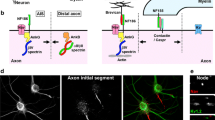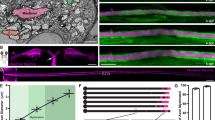Zusammenfassung
Neurone empfangen Eingangssignale, konvertieren diese in Aktionspotenziale und generieren schließlich Ausgangssignale auf ihren Zielzellen. Dabei sind die zu überwindenden räumlichen Distanzen oft groß. Daher ist entscheidend, dass elektrische Signale in Nervenzellen schnell von einem zum anderen Ort geleitet werden können. Diese wichtige Aufgabe erfüllt das Axon, der „Ausgangsfortsatz“ der Nervenzelle. Für die schnelle Leitung des Aktionspotenzials sind sowohl die passiven Eigenschaften des axonalen Kabels als auch die aktiven Eigenschaften der Zellmembran von entscheidender Bedeutung. Die Evolution bedient sich zweier Tricks, um die Leitungsgeschwindigkeit des Aktionspotenzials zu maximieren. Der eine Trick ist die Zunahme des Axondurchmessers. Der andere Trick ist die Ausbildung von Markscheiden. Dies führt bei nahezu gleichem Platzbedarf zu einer Zunahme der Leistungsgeschwindigkeit um fast zwei Größenordnungen. Die Aktionspotenzialleitung an myelinisierten Axonen erfolgt „saltatorisch“.
Access this chapter
Tax calculation will be finalised at checkout
Purchases are for personal use only
Similar content being viewed by others
Literatur
Arancibia-Carcamo IL, Attwell D (2014) The node of Ranvier in CNS pathology. Acta Neuropathol 128:161–175
Kandel ER, Schwartz JH, Jessell TM, Siegelbaum SA, Hudspeth AJ (2012) Principles of Neural Science, 5th edition, McGraw Hill, New York
Koh DS, Jonas P, Bräu ME, Vogel W (1992) A TEA-insensitive flickering potassium channel active around the resting potential in myelinated nerve. J Membr Biol 130:149–162
Kole MH, Stuart GJ (2012) Signal processing in the axon initial segment. Neuron 73:235–247
Schmidt-Hieber C, Jonas P, Bischofberger J (2008) Action potential initiation and propagation in hippocampal mossy fibre axons. J Physiol 586:1849–1857
Author information
Authors and Affiliations
Editor information
Editors and Affiliations
Rights and permissions
Copyright information
© 2019 Springer-Verlag GmbH Deutschland
About this chapter
Cite this chapter
Jonas, P. (2019). Aktionspotenzial: Fortleitung im Axon. In: Brandes, R., Lang, F., Schmidt, R.F. (eds) Physiologie des Menschen. Springer-Lehrbuch. Springer, Berlin, Heidelberg. https://doi.org/10.1007/978-3-662-56468-4_7
Download citation
DOI: https://doi.org/10.1007/978-3-662-56468-4_7
Publisher Name: Springer, Berlin, Heidelberg
Print ISBN: 978-3-662-56467-7
Online ISBN: 978-3-662-56468-4
eBook Packages: Medicine (German Language)




